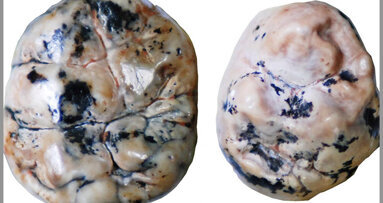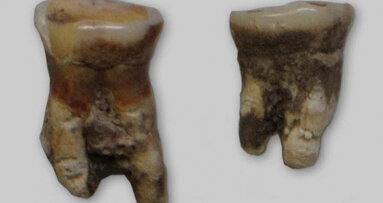STOCKHOLM, Sweden: Chewing gum has long been something that many people use. In a recent discovery in Scandinavia, researchers have found that the first humans who settled in the area more than 10,000 years ago left their DNA behind in ancient chewing gum. The gum, made up of masticated lumps of birch bark pitch, has produced the oldest human DNA sequenced from the region.
In Scandinavia, there are very few human remains that are older than 10,000 years and not all of them have preserved enough DNA for archaeogenetic studies. This discovery of three individuals’ DNA, that of two females and one male, creates an interesting link between material culture and human genetics and shows a close genetic affinity to other hunter-gatherers in Sweden and to early Mesolithic populations in Ice Age Europe.
According to the researchers, ancient chewing gum is an alternative source for human DNA and possibly a good proxy for human bones in archaeogenetic studies. The investigated pieces come from Huseby Klev, an early Mesolithic hunter-fisher site on the Swedish west coast. The site was excavated in the early 1990s, but at the time it was not possible to analyse ancient human DNA at all, let alone from non-human tissue.
“When Per Persson and Mikael Manninen proposed to look for hunter-gatherer DNA in these chewing gums from Huseby Klev, we were hesitant but really impressed that archaeologists took care during the excavations and preserved such fragile material,” said Natalija Kashuba, who was affiliated to the Museum of Cultural History at the University of Oslo when she performed the experiments in cooperation with Stockholm University.
Dr Emrah Kirdök of the Archaeological Research Laboratory at Stockholm University, who conducted the computational analyses of the DNA, stated: “Demography analysis suggests that the genetic composition of Huseby Klev individuals show more similarity to western hunter-gatherer populations than eastern hunter-gatherers.”
According to the researchers, the chewing gum may have potential not only for tracing the origin and movement of different groups but also for providing insights into their social relationships, diseases and food.
The study, titled “Ancient DNA from mastics solidifies connection between material culture and genetics of Mesolithic hunter-gatherers in Scandinavia”, was published on 15 May 2019 in Communications Biology.
Tags:
LEIPZIG, Germany: Statistical tracking has been a priority for the governments of Scandinavian countries in recent years, detailed records being kept on ...
TAIPEI, Taiwan: Conventional periodontal therapies, while effective to a degree, often fall short of fully restoring the complex architecture and function ...
BRISTOL, UK: The importance of mother’s milk to an infant’s development is now well established. In a recent study, researchers analysed the fossilised ...
COPENHAGEN, Denmark: Though its popularity and constituent ingredients have changed over time, chewing gum has been used by humans for thousands of years. A...
YORK, UK: Perhaps unfairly, the teeth of Britons have developed an international reputation for being crooked and aesthetically subpar. Researchers have ...
In a free Swiss Dental Academy webinar on Thursday, Feb. 27, host Melissa Obrotka will be providing educational insights on the stages of Guided Biofilm ...
YORK, UK: In new research, scientists have discovered that the diet of Mesolithic humans was much closer to the contemporary Mediterranean diet than first ...
CHICAGO, U.S.: Hydroxyapatite is an important component of hard tissue. Tooth enamel, for example, has the highest concentration of the mineral. Since ...
CHAMPIONSGATE, Fla., U.S.: In the interest of public health, the International Academy of Oral Medicine and Toxicology (IAOMT) has published a new research ...
HONG KONG, China/BERKELEY, Calif., US: A study led by researchers in China has recently examined the impact of the oral microbiota on overall health. The ...
Live webinar
Mon. 17 November 2025
12:00 pm EST (New York)
Prof. Dr. med. dent. Sebastian B. M. Patzelt M.Sc.
Live webinar
Tue. 18 November 2025
11:00 am EST (New York)
Live webinar
Tue. 18 November 2025
1:00 pm EST (New York)
Live webinar
Tue. 18 November 2025
2:00 pm EST (New York)
Dr. Nicola M. Grande DDS, PhD
Live webinar
Tue. 18 November 2025
2:00 pm EST (New York)
Prof. Dr. Raphael Monte Alto
Live webinar
Wed. 19 November 2025
1:00 pm EST (New York)
Live webinar
Wed. 19 November 2025
7:00 pm EST (New York)



 Austria / Österreich
Austria / Österreich
 Bosnia and Herzegovina / Босна и Херцеговина
Bosnia and Herzegovina / Босна и Херцеговина
 Bulgaria / България
Bulgaria / България
 Croatia / Hrvatska
Croatia / Hrvatska
 Czech Republic & Slovakia / Česká republika & Slovensko
Czech Republic & Slovakia / Česká republika & Slovensko
 France / France
France / France
 Germany / Deutschland
Germany / Deutschland
 Greece / ΕΛΛΑΔΑ
Greece / ΕΛΛΑΔΑ
 Hungary / Hungary
Hungary / Hungary
 Italy / Italia
Italy / Italia
 Netherlands / Nederland
Netherlands / Nederland
 Nordic / Nordic
Nordic / Nordic
 Poland / Polska
Poland / Polska
 Portugal / Portugal
Portugal / Portugal
 Romania & Moldova / România & Moldova
Romania & Moldova / România & Moldova
 Slovenia / Slovenija
Slovenia / Slovenija
 Serbia & Montenegro / Србија и Црна Гора
Serbia & Montenegro / Србија и Црна Гора
 Spain / España
Spain / España
 Switzerland / Schweiz
Switzerland / Schweiz
 Turkey / Türkiye
Turkey / Türkiye
 UK & Ireland / UK & Ireland
UK & Ireland / UK & Ireland
 Brazil / Brasil
Brazil / Brasil
 Canada / Canada
Canada / Canada
 Latin America / Latinoamérica
Latin America / Latinoamérica
 USA / USA
USA / USA
 China / 中国
China / 中国
 India / भारत गणराज्य
India / भारत गणराज्य
 Pakistan / Pākistān
Pakistan / Pākistān
 Vietnam / Việt Nam
Vietnam / Việt Nam
 ASEAN / ASEAN
ASEAN / ASEAN
 Israel / מְדִינַת יִשְׂרָאֵל
Israel / מְדִינַת יִשְׂרָאֵל
 Algeria, Morocco & Tunisia / الجزائر والمغرب وتونس
Algeria, Morocco & Tunisia / الجزائر والمغرب وتونس
 Middle East / Middle East
Middle East / Middle East














































To post a reply please login or register